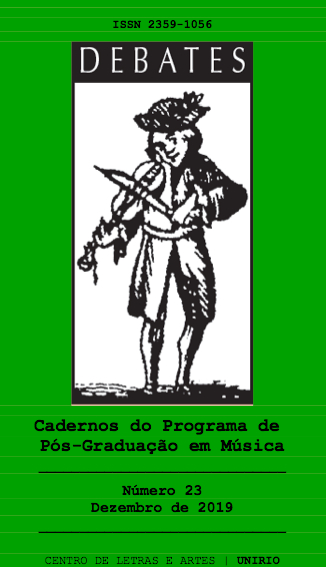“Every Something is an Echo of Nothing”: Notes on The John Cage Project in Halberstadt
Keywords:
John Cage, site specific, ORGAN2/ASLSPAbstract
The text “Every Something is an Echo of Nothing”: Notes on The John Cage Project in Halberstadtaddresses TheJohn Cage Organ Project, the first trans-epochal work of art in music history. It is inspired by the American avant-garde composer and artist’s ORGAN2/ASLSP, which has been played at Saint Burchardi Church in Halberstadt, Germany, since 2001, and is expected to last until 2640. Different aspects involved in the Project are analyzed, such as its history, aesthetics, philosophy, and its utopian vision, as well as John Cage’s conception of time, which provides basis for the project.
Downloads
References
BIBLIOGRAPHY:
BOSSEUR, Dominique. “L’expérience du temps chez Cage”. In: Musique em Jeu no1. Paris: Seuil, 1970, p.16-22.
BOSSEUR, Jean-Yves. John Cage. Paris: Minerve, 1993.
CAGE, John. Silence. Middletown, Connecticut: Wesleyan University Press.1974, 2nd ed.
CAGE, John. A year from Monday. Middletown, Connecticut: Wesleyan University Press.1975, 3rd ed. CAGE, John & SCHÖNING, KLAUS. Laughtears _ Conversation on Roaratorio. Paris: 13/15 August,
JOHN-CAGE-ORGEL-KUNST-PROJECT Booklet. Halberstadt: John-Cage-Orgel-Stiftung, 2017. NIETZSCHE, Frederico. A origem da tragédia. Lisboa: Guimarães & C.a, 3rd ed., 1982.
TERRA, Vera. Acaso e aleatório na música: um estudo da indeterminação nas poéticas de Cage e
Boulez. São Paulo: Educ/Fapesp, 2000.
VIOLA, Bill. “O som de um raio de transmissão”. In: Zaremba, Lilian; BENTES, Ivana (org). Radio Nova,
constelações da radiofonia contemporânea. Rio de Janeiro: UFRJ, ECO, Publique.1996, p.43-60.
WEB SOURCES:
CAGE, John. “Works”. https://johncage.org/pp/John-Cage-Work-Detail.cfm?work_ID=30. Acesso em 8 de novembro de 2019.
CAGE, John. “Works”. https://johncage.org/pp/John-Cage-Work-Detail.cfm?work_ID=31. Acesso em 20 de novembro de 2019.
HALBERSTADT Organ. https://www.domorgel-hbs.de/de/die-orgel/orgelchronik.html
MEYER, Jürgen. “Acoustics of gothic churches”.
http://www.conforg.fr/acoustics2008/cdrom/data/fa2002-sevilla/forumacusticum/archivos/rba05002.pdf Acesso em 10 de outubro de 2019.
NICHOLAS, Vanessa. “Sound by artists”. http://www.magentafoundation.org/magazine/sound-by-artists/ Magenta Magazine, ©2019. Acesso em 9 de setembro de 2019.
ORGANUM GRUNIGENSE REDIVIVUM. https://www.praetorius-beckorgel.de/en/kirche.php, 2011. Acesso em 18 de outubro de 2019.
PETERS, Edition. “ORGAN2/ASLSP”. https://issuu.com/editionpeters/docs/www.editionpeters.com August 8, 2011. Acesso em 3 de novembro de 2019.
PETERS, Edition. “ASLSP”. https://johncage.org/pp/John-Cage-Work-Detail.cfm?work_ID=30 Acesso em 3 de novembro de 2019.
SHLOMOWITZ, Matthew. Cage’s place in the reception of Satie. https://www.shlom.com/?p=cagesatie. San Diego, 1999. Acesso em 9 de setembro de 2019
Zea E-Books. Book 24. Praetorius, Michael and Faulkner, Quentin trans. & ed., "Syntagma Musicum II: De Organographia, Parts III – V with Index" (2014), p. 98. https://digitalcommons.unl.edu/zeabook/24/ August 25, 2014. Acesso em 26 de setembro de 2019.
NOTES
The text was originally written in English, reviewed by Mr. Wellington da Silva Amorim Jr., and then translated to Portuguese.
The photos were taken with camera phone, during a visit to Halberstadt in August, 2019.
A special thanks to Prof. Dr. Rainer O. Neugebauer, social scientist, chairman of the John Cage Organ Project in Halberstadt, for graciously giving me an interview about the project, which provided an important source for writing the text.


